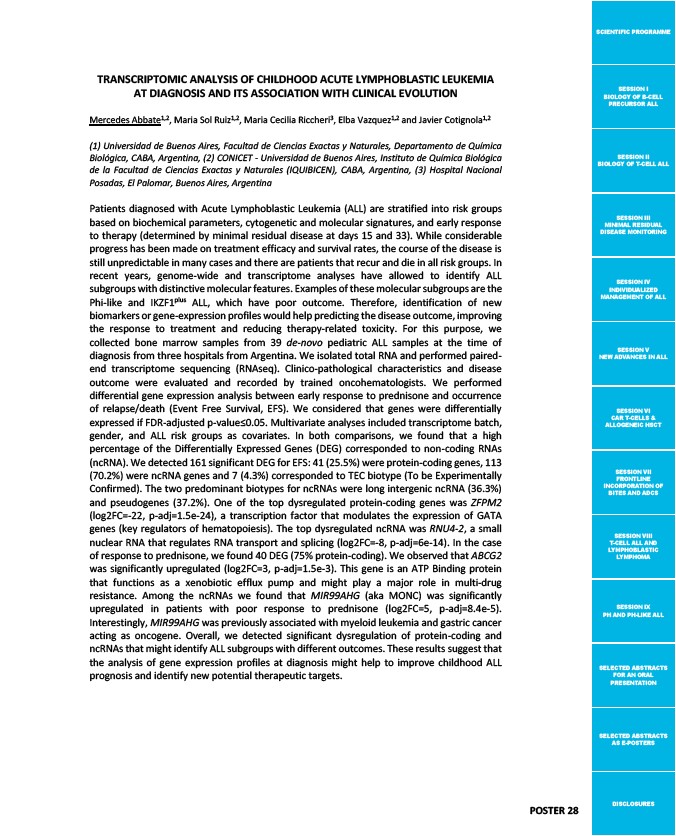
SCIENTIFIC PROGRAMME
SESSION I
BIOLOGY OF B-CELL
PRECURSOR ALL
SESSION II
BIOLOGY OF T-CELL ALL
SESSION III
MINIMAL RESIDUAL
DISEASE MONITORING
SESSION IV
INDIVIDUALIZED
MANAGEMENT OF ALL
SESSION V
NEW ADVANCES IN ALL
SESSION VI
CAR T-CELLS &
ALLOGENEIC HSCT
SESSION VII
FRONTLINE
INCORPORATION OF
BITES AND ADCS
SESSION VIII
T-CELL ALL AND
LYMPHOBLASTIC
LYMPHOMA
SESSION IX
PH AND PH-LIKE ALL
SELECTED ABSTRACTS
FOR AN ORAL
PRESENTATION
SELECTED ABSTRACTS
AS E-POSTERS
DISCLOSURES
TRANSCRIPTOMIC ANALYSIS OF CHILDHOOD ACUTE LYMPHOBLASTIC LEUKEMIA
AT DIAGNOSIS AND ITS ASSOCIATION WITH CLINICAL EVOLUTION
Mercedes Abbate1,2, Maria Sol Ruiz1,2, Maria Cecilia Riccheri3, Elba Vazquez1,2 and Javier Cotignola1,2
(1) Universidad de Buenos Aires, Facultad de Ciencias Exactas y Naturales, Departamento de Química
Biológica, CABA, Argentina, (2) CONICET - Universidad de Buenos Aires, Instituto de Química Biológica
de la Facultad de Ciencias Exactas y Naturales (IQUIBICEN), CABA, Argentina, (3) Hospital Nacional
Posadas, El Palomar, Buenos Aires, Argentina
Patients diagnosed with Acute Lymphoblastic Leukemia (ALL) are stratified into risk groups
based on biochemical parameters, cytogenetic and molecular signatures, and early response
to therapy (determined by minimal residual disease at days 15 and 33). While considerable
progress has been made on treatment efficacy and survival rates, the course of the disease is
still unpredictable in many cases and there are patients that recur and die in all risk groups. In
recent years, genome-wide and transcriptome analyses have allowed to identify ALL
subgroups with distinctive molecular features. Examples of these molecular subgroups are the
Phi-like and IKZF1plus ALL, which have poor outcome. Therefore, identification of new
biomarkers or gene-expression profiles would help predicting the disease outcome, improving
the response to treatment and reducing therapy-related toxicity. For this purpose, we
collected bone marrow samples from 39 de-novo pediatric ALL samples at the time of
diagnosis from three hospitals from Argentina. We isolated total RNA and performed paired-end
transcriptome sequencing (RNAseq). Clinico-pathological characteristics and disease
outcome were evaluated and recorded by trained oncohematologists. We performed
differential gene expression analysis between early response to prednisone and occurrence
of relapse/death (Event Free Survival, EFS). We considered that genes were differentially
expressed if FDR-adjusted p-value≤0.05. Multivariate analyses included transcriptome batch,
gender, and ALL risk groups as covariates. In both comparisons, we found that a high
percentage of the Differentially Expressed Genes (DEG) corresponded to non-coding RNAs
(ncRNA). We detected 161 significant DEG for EFS: 41 (25.5%) were protein-coding genes, 113
(70.2%) were ncRNA genes and 7 (4.3%) corresponded to TEC biotype (To be Experimentally
Confirmed). The two predominant biotypes for ncRNAs were long intergenic ncRNA (36.3%)
and pseudogenes (37.2%). One of the top dysregulated protein-coding genes was ZFPM2
(log2FC=-22, p-adj=1.5e-24), a transcription factor that modulates the expression of GATA
genes (key regulators of hematopoiesis). The top dysregulated ncRNA was RNU4-2, a small
nuclear RNA that regulates RNA transport and splicing (log2FC=-8, p-adj=6e-14). In the case
of response to prednisone, we found 40 DEG (75% protein-coding). We observed that ABCG2
was significantly upregulated (log2FC=3, p-adj=1.5e-3). This gene is an ATP Binding protein
that functions as a xenobiotic efflux pump and might play a major role in multi-drug
resistance. Among the ncRNAs we found that MIR99AHG (aka MONC) was significantly
upregulated in patients with poor response to prednisone (log2FC=5, p-adj=8.4e-5).
Interestingly, MIR99AHG was previously associated with myeloid leukemia and gastric cancer
acting as oncogene. Overall, we detected significant dysregulation of protein-coding and
ncRNAs that might identify ALL subgroups with different outcomes. These results suggest that
the analysis of gene expression profiles at diagnosis might help to improve childhood ALL
prognosis and identify new potential therapeutic targets.
POSTER 28